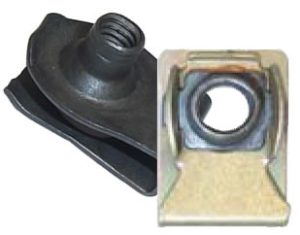
Nuts are commonly used in conjunction with a bolt. To secure two or more parts together, you can place a nut through the parts. You can then twist a nut onto the end of the bolt. While most nuts feature a traditional hexagonal shape, however, others feature a different shape. There are speed nuts, for instance, that look like clips.
Overview of Speed Nuts
Speed nuts are clip-like fasteners with a hole in the center. The hole is designed to accommodate a threaded bolt. After driving the threaded bolt through a set of parts, you can attach a speed nut to it. The speed nut will act as a locking nut to prevent the threaded bolt from loosening and falling out.
Benefits of speed nuts include the following:
- Quick and easy to install
- Eliminates the need for a separate locking washer
- Protects against loosening
- Durable and long-lasting
How Speed Nuts Work
Speed nuts are typically made of spring steel. When twisted onto the end of a threaded bolt, the prongs will deform while simultaneously applying pressure to the fastener. This pressure will lock the threaded bolt in place.
Traditional nuts aren’t designed to lock threaded bolts in place. Rather, they are only designed to hold the parts with which they are used together. There are locking nuts, though, they both hold together the parts with which they are used and lock threaded bolts together. Speed nuts fall under this category. They are known as “speed nuts” because they are quick and easy to install — more so than other types of locking nuts.
The Different Types of Speed Nuts
All speed nuts feature a similar clip-like design, and they all act as locking nuts. With that said, speed nuts are available in different styles. There are J-nut and U-nut speed nuts. Both J-nut and U-nut speed nuts feature a clip-like design that’s characterized by the use of two prongs. J-nut speed nuts are shaped like the letter J, whereas U-nut speed nuts are shaped like the letter U.
J-nut speed nuts have two prongs, one of which is slightly shorter than the other prong. This nuance in length results in the shape of the letter J. U-nut speed nuts, in comparison, have two prongs of equal length, resulting in the shape of the letter U. Regardless, J-nut and U-nut speed nuts are used for the same purpose of holding two or more parts together while also locking the threaded bolt.



